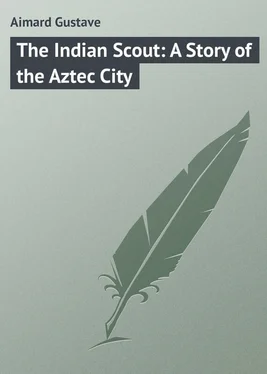Gustave Aimard - The Indian Scout - A Story of the Aztec City
Здесь есть возможность читать онлайн «Gustave Aimard - The Indian Scout - A Story of the Aztec City» — ознакомительный отрывок электронной книги совершенно бесплатно, а после прочтения отрывка купить полную версию. В некоторых случаях можно слушать аудио, скачать через торрент в формате fb2 и присутствует краткое содержание. Жанр: foreign_prose, на английском языке. Описание произведения, (предисловие) а так же отзывы посетителей доступны на портале библиотеки ЛибКат.
- Название:The Indian Scout: A Story of the Aztec City
- Автор:
- Жанр:
- Год:неизвестен
- ISBN:нет данных
- Рейтинг книги:4 / 5. Голосов: 1
-
Избранное:Добавить в избранное
- Отзывы:
-
Ваша оценка:
- 80
- 1
- 2
- 3
- 4
- 5
The Indian Scout: A Story of the Aztec City: краткое содержание, описание и аннотация
Предлагаем к чтению аннотацию, описание, краткое содержание или предисловие (зависит от того, что написал сам автор книги «The Indian Scout: A Story of the Aztec City»). Если вы не нашли необходимую информацию о книге — напишите в комментариях, мы постараемся отыскать её.
The Indian Scout: A Story of the Aztec City — читать онлайн ознакомительный отрывок
Ниже представлен текст книги, разбитый по страницам. Система сохранения места последней прочитанной страницы, позволяет с удобством читать онлайн бесплатно книгу «The Indian Scout: A Story of the Aztec City», без необходимости каждый раз заново искать на чём Вы остановились. Поставьте закладку, и сможете в любой момент перейти на страницу, на которой закончили чтение.
Интервал:
Закладка:
The Cordillera of the Andes, that immense spine of the American continent, the whole length of which it traverses under different names from north to south, forms, at various elevations, immense llanos , on which entire people live at a height at which all vegetation ceases in Europe.
After crossing the Presidio de Tubar, the advanced post of civilization on the extreme limit of the desert, and advancing into the mediano region of the tierra caliente for about one hundred and twenty miles, the traveller finds himself suddenly, and without any transition, in front of a virgin forest, which is no less than three hundred and twenty miles deep, by eighty odd miles wide.
The most practised pen is powerless to describe the marvels innumerable inclosed in that inexhaustible network of vegetation called a virgin forest, and the sight, at once strange and peculiar, majestic and imposing, which it offers to the dazzled sight. The most powerful imagination recoils before this prodigious fecundity of elementary nature, continually springing up again from its own destruction with a strength and vigour ever new. The creepers, which run from tree to tree, from branch to branch, plunge, at one moment, into the earth, and then rise once more to the sky, and form, by their interlacing and crossing, an almost insurmountable barrier, as if jealous nature wished to hide from profane eyes the mysterious secrets of these forests, beneath whose shade man's footsteps have only reached at long intervals, and never unpunished. Trees of every age and species grow without order or symmetry, as if sown by chance, like wheat in the furrows. Some, tall and slight, count only a few years; the extremities of their branches are covered by the tall and wide boughs of those whose haughty heads have seen centuries pass over them. Beneath their foliage softly murmur pure and limpid streams, which escape from the fissures of the rocks, and, after a thousand meanderings, are lost in some lake or unknown river, whose bright waters had never reflected aught in their clear mirror save the sublime secrets of the solitude. There may be found, pell-mell and in picturesque confusion, all the magnificent productions of tropical regions: – The acajou; the ebony; the palisander; the stunted mahogany; the black oak; the cork; the maple; the mimosa, with its silvery foliage; and the tamarind, thrusting in every direction their branches, laden with, flowers, fruits, and leaves, which form a dome impenetrable to the sunbeams. From the vast and unexplored depths of these forests emerge, from time to time, inexplicable noises – furious howls, feline miauls, mocking yells, mingled with shrill whistling or the joyous and harmonious song of the birds.
After plunging boldly into the centre of this chaos, and struggling hand to hand with this uncultivated and wild nature, the traveller succeeds, with axe in one hand and torch in the other, in gaining, inch by inch, step by step, a road impossible to describe. At one moment, by crawling like a reptile over the decaying leaves, dead wood, or guano, piled up for centuries; or by leaping from branch to branch, at the tops of the trees, standing, as it were, in the air. But woe to the man who neglects to have his eye constantly open to all that surrounds him, and his ear on the watch: for, in addition to the obstacles caused by nature, he has to fear the venomous stings of the serpents startled in their lairs, and the furious attacks of the wild beasts. He must also carefully watch the course of the rivers and streams he meets with, determine the position of the sun during the day, or guide himself at night by the Southern Cross; for, once astray in a virgin forest, it is impossible to get out of it – it is a maze, from which no Ariadne's web would help to find the issue.
At last the traveller, after he has succeeded in surmounting the dangers we have describe, and a thousand others no less terrible, which we have passed over in silence, emerges on an immense plain, in the centre of which stands an Indian city. That is to say, he finds himself before one of those mysterious cities into which no European has yet penetrated, whose exact position even is unknown, and which, since the conquest, have served as an asylum for the last relics of Aztec civilization.
The fabulous accounts given by some travellers about the incalculable wealth buried in these cities, has inflamed the covetousness and avarice of a great number of adventurers, who, at various periods, have attempted to find the lost road to these queens of the Mexican prairies and savannahs. Others again, only impelled by the irresistible attraction extraordinary enterprises offer to vagabond imaginations, have also, especially during the last fifty years, set out in search of these Indian cities, though up to the present time success has never crowned these various expeditions. Some have returned disenchanted, and half killed by this journey toward the unknown; a considerable number have left their bodies at the foot of precipices or in the quebradas, to serve as food for birds of prey; while others, more unfortunate still, have disappeared without leaving a trace, and no one has ever heard what has become of them.
Owing to events, too long to narrate here, but which we shall describe some day, we have lived, against our will, in one of these impenetrable cities, though, more fortunate than our predecessors, whose whitened bones we saw scattered along the road, we succeeded in escaping from it, through dangers innumerable, all miraculously avoided. The description we are about to give, then, is scrupulously exact, and cannot be doubted, for we write from personal observation.
Quiepaa Tani, the city which presents itself to the traveller's sight after leaving the virgin forest, of which we have given a sketch, extends from east to west, and forms a parallelogram. A wide stream, over which several bridges of incredible lightness and elegance are thrown, runs through its entire length. At each corner of the square an enormous block of rock cut perpendicularly on the side that faces the plains, serves as an almost impregnable fortress; these four citadels are also connected by a wall twenty feet thick, and forty feet high, which, inside the city, forms a slope sixty feet wide at the base. This wall is built of native bricks, made of sandy earth and chopped straw; they are called adobes , and are about a yard long. A wide and deep fosse almost doubles the height of the walls. Two gates alone give access to the city. These gates are flanked by towers and pepper boxes, exactly like a mediaeval fortress; and, what adds to the correctness of our comparison, a small bridge, made of planks, extremely narrow and light, and so arranged as to be carried away on the slightest alarm, is the only communication between these gates and the exterior.
The houses are low, and terminate in terraces, connected with each other; they are slight, and built of wicker and canaverales covered with cement, in consequence of the earthquakes so frequent in these regions; but they are large, airy, and pierced with numerous windows. None of them are more than one story in height, and the fronts are covered with a varnish of dazzling whiteness.
This strange city, seen from a distance, as it rises in the midst of the tall prairie grass, offers the most singular and seductive sight.
On a fine evening in the month of October, five travellers, whose features or dress it would have been impossible to distinguish, owing to the obscurity, came out of the forest we have described above, stopped for a moment, with marked indecision, on the extreme edge of the wood, and began examining the ground. Before them rose a hillock, which, if no great height, yet cut the horizon at right angles.
After exchanging a few words, two of these persons remained where they were; the other three lay down on their faces, and, crawling on their hands and feet, advanced through the rank grass, which they caused to undulate, and which completely concealed their bodies. On reaching the top of the mound, which they had found such difficulty in scaling, they looked out into the country, and remained struck with astonishment and admiration.
Читать дальшеИнтервал:
Закладка:
Похожие книги на «The Indian Scout: A Story of the Aztec City»
Представляем Вашему вниманию похожие книги на «The Indian Scout: A Story of the Aztec City» списком для выбора. Мы отобрали схожую по названию и смыслу литературу в надежде предоставить читателям больше вариантов отыскать новые, интересные, ещё непрочитанные произведения.
Обсуждение, отзывы о книге «The Indian Scout: A Story of the Aztec City» и просто собственные мнения читателей. Оставьте ваши комментарии, напишите, что Вы думаете о произведении, его смысле или главных героях. Укажите что конкретно понравилось, а что нет, и почему Вы так считаете.












